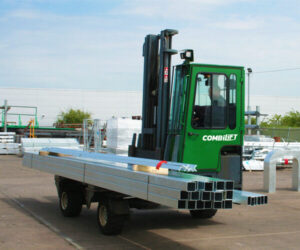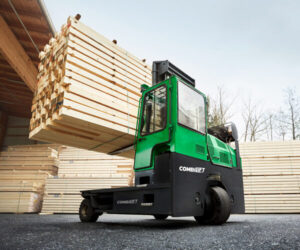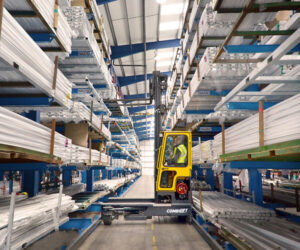When Combilift was established, no one could have imagined that a forklift over 16 tonnes could run on electricity alone. But the flagship C-Series has always been ahead of its time
In a move that reinforces its sustainable credentials, Combilift has responded to customer demand and electrified an already ground-breaking range of forklifts. Combilift Country Manager for Australia, Chris Littlewood, says it was impossible to ignore the wave of support for greener machines. “We pride ourselves on listening to customer feedback – it fuels our value of innovation – and electric options were high on the list,” he says. “Where before we offered the choice between diesel or LPG, electric engines are now available on C-Series capacities up to 18-tonne.”
The manufacturer first established the C-Series’ multidirectional concept in 1998, becoming the world’s first to develop the internal combustion multidirectional forklift. Since then, Combilift has been proactive in delivering machines which meet and exceed customer expectations of performance and sustainability. Considering this history of innovation, it’s no surprise that Combilift is shifting the dial in heavy forklift design. The C-Series also removes the need for cumbersome built-on cast weight at the rear and instead incorporates it into the chassis. This allows operators to navigate narrower aisles and improves the efficiency of warehouse floorplans.
This also supports Combilift’s drive for greater sustainability, as an efficient warehouse means a reduced footprint and associated costs of heating, lighting, and maintenance. This ethos is the reason for Combilift’s complementary warehouse optimisation service. Some of the manufacturer’s customers have doubled their storage capacity simply by switching to Combilift forklifts and redesigning accordingly. Chris says this is especially important to his Australian customers where industrial real estate is at a premium.
“Warehouse space may be a hot commodity, but building more of them isn’t necessarily the answer,” he says. “At Combilift, we believe we should start by optimising the floorspace we do have and the reassessing our needs from there. “That way, we’re not building new facilities unnecessarily or prematurely on land that could be used more effectively.” Who could have imagined the far-reaching benefits of Combilift’s multidirectional technology when it was conceived in 1998? Of course, emissions regulations and electric vehicles were hardly discussed back then, but Combilift has combined the best in productivity and sustainability to suit modern requirements.
C-Series specs
The C-Series is effectively three forklifts in one, saving customers on warehouse space, turnaround times, and overall asset management. So, while the electric motor saves emissions, operators can save time and money for their business. The design combines the advantages of a counterbalanced forklift, side loader and very narrow aisle forklifts, suiting a wide range of industries. These include aluminium, building materials, concrete, logistics, metals, plastics, steel, and timber. The vehicle was designed to navigate awkward loads through doorways as narrow as 2.8 metres, while also perfect for palletised loads, block stacking, and loading in confined areas. Chris affirms that it really is the perfect all-rounder.
“We thought for years that the C-Series was perfect as it was, with the functionality to tackle so many logistical nightmares,” he says. “But only when we electrified the motor did we realise there is always more innovation to be done. This addition has only bolstered an already impressive machine.” The next step for Combilift is to electrify even more models from the C-Series range, allowing more businesses to meet their own sustainability goals.
Chris explains why electric models only go up to 18-tonne so far. “These are the core models in the range and the ones which receive the most interest. As I mentioned, we listen to our customers and respond with solutions based on market demand,” he said. “Once these electric models are well-established, we will invest in electrifying those above 18 tonnes. But for now, it’s about generating awareness that we are the home of powerful, electric forklifts.”










